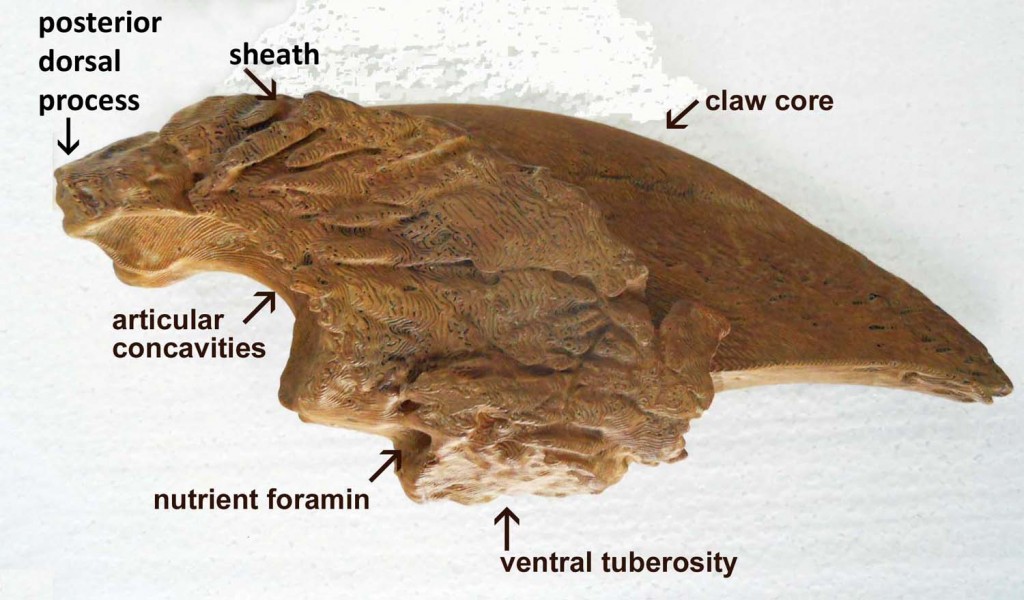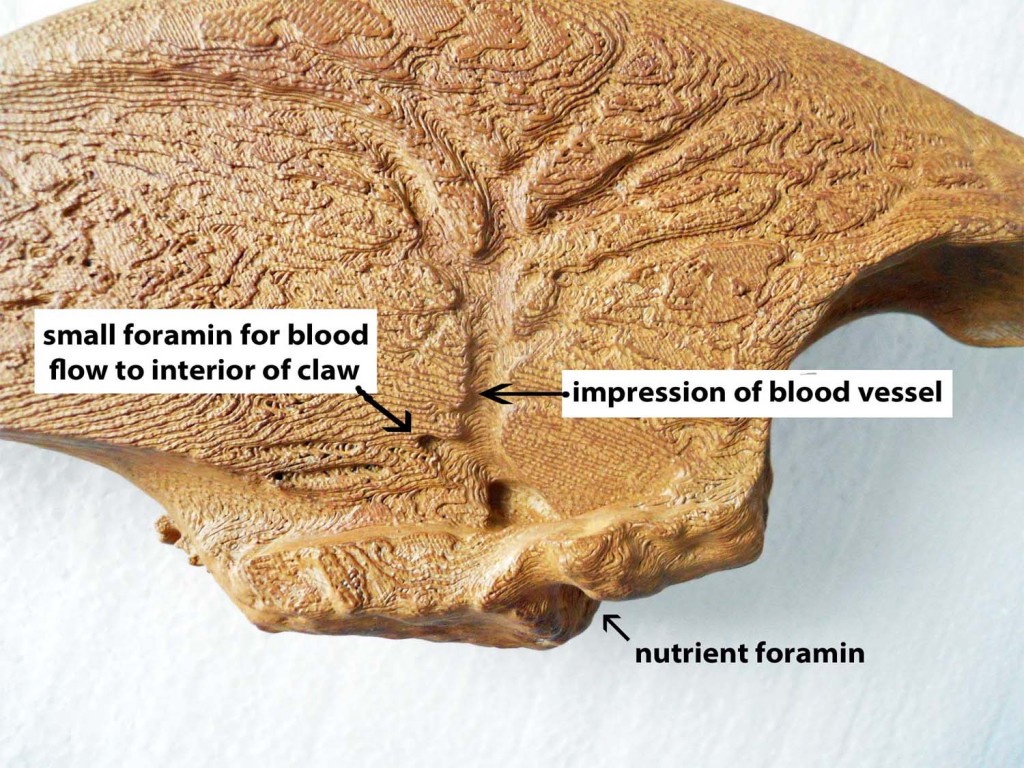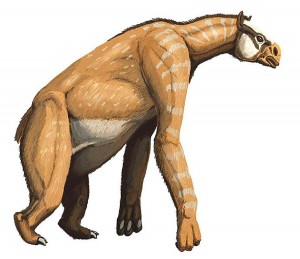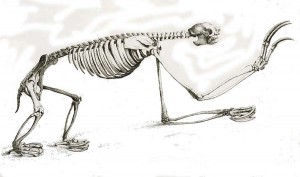Introduction to Walk Like a Sloth: lessons in ground sloth locomotion
 Getting Oriented
Getting Oriented
The claw is from the middle toe of the left foot. It’s the largest of all of the claws. In life the bony core would have been covered with a toenail growing out of the pocket or sheath at the wide end. The nail probably didn’t extend far beyond the tip. Sloth claws didn’t retract like a cat’s so a long nail would get in the way of planting the foot down flat and would have abraded quickly. Half of the nail sheath is missing from the specimen (broken off after burial) but the accident reveals the impressions left by the major blood vessels feeding the nail and penetrating into the interior through foramina (holes). The ventral tuberosity would have supported a tough pad of tissue on which the sloths walked, lifting the tip of the claw slightly off the ground.
 Key points
Key points
#1 Thomas Jefferson proposed the name Megalonyx or “giant claw” based on the discovery of a relatively small claw from the middle finger of the forelimb of the sloth and suggested it might be a giant lion 3X bigger than an African lion. Imagine how impressed he would have been if he had found this claw from the foot—it is twice (2X) the size of the one in Jefferson’s possession!
#2 Megalonyx had 4 claws on each front paw (it’s missing a “thumb” claw) and 3 claws on each foot. The claws on either side of the middle claw on the toes are smaller and slightly flattened on the side facing the center and convex on the side facing away from the center. Toe claws can be distinguished from the hand claws by their greater curvature and generally more robust character. (Hoganson and McDonald, 2007) The size, central location and symmetry of shape around this claw tell scientists Megalonyx walked flat-footed and not on the sides of its feet like most other sloths.
#3 Herbivores generally have hooves or small nails. Sometimes their nails are sharp but the bone beneath the nail is blunt like in humans (see photo above). True claws have a pointed bone shaped to support the nail throughout its length Ground sloths are rare among all the large herbivores that have ever lived in having real claws (See the Chalicothere, also a strange beast, for an exception).
#4 The bones at the ends of fingers and toes are called unguals from the Latin word unguis meaning “nail,” “claw” or “hoof.”
 Additional information
Additional information
If Jefferson had been more skilled in anatomy he might have noted some important
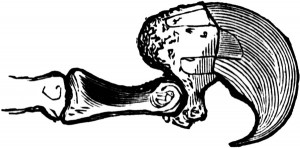
CAT CLAW
(Clipart courtesy FCIT)
differences between his claws and those of a lion or cat. Sloth claws are 4X longer than they are high. . . cats’ claws are much shorter, and in some cases even higher than they are long. That gives the claw better leverage and the tip more power for piercing thick hides when the animals flex their toes. Anatomy experts like Cuvier also noted differences in the way the blood vessels entered the claws and the way the claw articulates with the rest of the toe and knew that, as impossible as it seemed, this claw belonged to a sloth! (Cuvier, 1812) On the other hand, the claws of both tree sloths and domestic cats are all about equal in size–in the fossil animals they are very different sizes. Clearly ground sloths were doing something different with them.
Jefferson soon realized he had made a mistake identifying his mystery creature as a lion and determined Megalonyx was a new kind of sloth, but his discovery led early paleontologists to some amazing conclusions. Some decided the claws must be used for burrowing, like sloths’ close relative, anteaters. They decided ground sloths were essentially earth-whales living like giant moles, but eating ants. (Owen, 1842) Others pointed to the way tree sloths used their claws and concluded that giant sloths lived in the trees too. True,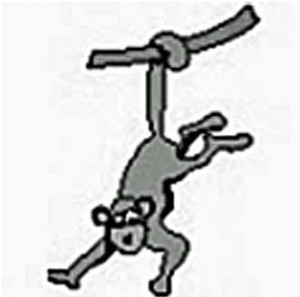 tree sloths didn’t have tails like Megalonyx, but that could only mean one thing—their tails were prehensile and they used them to help them hang, like monkeys. (ibid.)
tree sloths didn’t have tails like Megalonyx, but that could only mean one thing—their tails were prehensile and they used them to help them hang, like monkeys. (ibid.)
 Things to do
Things to do
Try articulating (connecting) this claw with the other two bones of the toe (see Toe lesson). There’s no problem identifying up and down or the right order of the bones if you remember that tightly connecting bones and joints are a hallmark of mammals. If Jefferson had had more experience with anatomy he might have noticed some other important differences between sloths and lions and other cats in the way they bend their toes. Cats can retract their claws by folding them back and up off the ground. That way their ungual digits never touch the ground when they walk and they can keep their claws sharp. Hold the toe bone flat and try bending the sloth’s claw up. You can’t! Note in the illustration how the top of the phallanx (toe bone) behind a cat’s claw is concave to receive the retracted claw. No recess in sloths. You can bend the claw virtually straight down, making a right angle to the toe bone but the dorsal articulating surface of the claw curves back and over the proximal toe bone (called the posterior dorsal process) creating a hard stop preventing the claw from retracting. Together, the toe and claw sit flat on the ground making a long stable base on which to sit, stand or walk.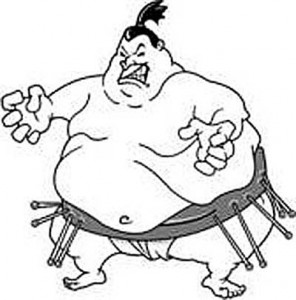
Tear-down-trees-like-a-sloth Some early paleontologists imagined sloths ate by uprooting trees–not knocking them down with their heads and trunks like elephants, but rather first digging to expose and sever the roots all around the trunk, then setting its claws like spikes on a track shoe to anchor its feet in the ground. It could then then grasp the trunk tightly with its front claws in a powerful bear hug and rip the tree out of the ground–like a sumo wrestler grabbing his opponent in a bear hug and throwing him down. (Owen, 1842) Get in this position and mimic the sequence. Can you feel the weight on your toes? Could you do this without claws?
Dig-like-a-sloth— Digging is a bipedal activity and the vertebral column (back bones) of burrowing animals can look very 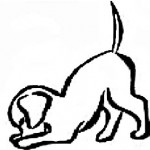 much like those of one walking upright. Get down on all fours and pretend you are going to dig a burrow. Your center of gravity has to be far in back over your hind legs so you can stretch out arms and reach for handfuls of soil. Now imagine yourself a horse or cow and lean forward putting most of your weight on your front arms. . . try digging. . . you can’t without falling over! All most quadrupeds can do is paw the ground with one foot at a time. . . unless, like dogs, they can bend their backbones into a tight “U” and pull their centers of mass back over their hips.
much like those of one walking upright. Get down on all fours and pretend you are going to dig a burrow. Your center of gravity has to be far in back over your hind legs so you can stretch out arms and reach for handfuls of soil. Now imagine yourself a horse or cow and lean forward putting most of your weight on your front arms. . . try digging. . . you can’t without falling over! All most quadrupeds can do is paw the ground with one foot at a time. . . unless, like dogs, they can bend their backbones into a tight “U” and pull their centers of mass back over their hips.
Read a Native American legend that may be about sloths: Ice Age animals, including possibly Megalonyx, figured in the mythology of many Native American cultures. Mammoth and mastodon tusks and teeth were generally interpreted as the horns and teeth respectively of giant bison. (Mayor, 2005) Stories about the giant bison are widespread, but legends clearly about sloths are difficult to identify. Sloth claws would have been the most distinctive bone and could have been incorporated into stories about a giant bear or lion. A Meskwaki legend offers the most intriguing possibility:
The fight between Long Claws and Skunk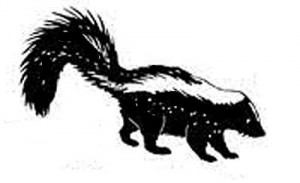 , a summary
, a summary
Long Claws was as big as a bear and had giant claws that rattled when he walked. He was fast but lazy, and he feared nothing. All the other animals in the forest fled when Long Claws came around until one day when Skunk decided to confront him. Skunk and Long Claws traded insults. . . Long Claws challenged Skunk to fight instead of turning his back like a coward. . . Skunk warned Long Claws to surrender. When he didn’t, Skunk squirted him in the face with his smell and Long Claws died. Skunk made his claws into a necklace. All the people admired it and started wearing them too. The people only started making necklaces with bear claws after all of the Long Claws disappeared. (Jones, 1939).
The Jefferson Puzzle Three claws were among the bones Thomas Jefferson had available to figure out what kind of animal a sloth was. People laugh at Jefferson’s mistake thinking the sloth was a giant lion, but it’s impossible for today’s students to comprehend the puzzle he faced at the time. Dinosaurs hadn’t been discovered and extinction was believed impossible. Therefore, his unusual bones logically had to come from a living animal, but one that hadn’t been seen before. At that time, big unknown bones when unearthed were simply presumed to belong to elephants and hippos drowned in Noah’s flood. The Earth was believed to be 6,000 years old and no one knew about the Ice Ages. To review Jefferson’s position, try the following: Step 1 Place several bones from the kit on the floor or a table. Step 2 Organize the students into groups of 4-5 and ask them to imagine the situation as described above. Step 3 Ask the groups to answer the three (3) fundamental questions everyone would have about an unknown animal: 1) How big is it? (i.e. what does it weigh?) 2) What does the animal eat? 3) Where does it live (in the water, in trees, underground, etc.) and how does it move in that environment? (i.e. does it climb, swim, run, etc.) 4) Remind the students to record their solutions and assumptions because they will have to defend their answers at the end of class. Step 4 Let each group meet and come up with their answers. Provide rulers and tape measures. Step 5 Have a spokesperson from each group present and support their conclusions. Step 6 Lead a class discussion about the pros and cons of different answers. Remind students that scientists are still struggling to determine the answers to all of these questions about Megalonyx.
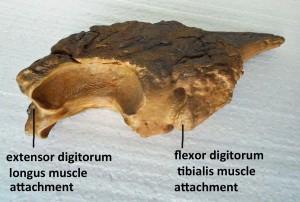 Flex Your Muscles Look for the knob located between the two (2) nutient foramina on the posterior (back) end of the claw. That’s the attachment point for the flexor digitorum tibialis muscle. The muscle is anchored on the back of the tibia but narrows to a tendon near the ankle and passes through the foot and toe to the back of the claw. Pulling on the muscle curls, i.e. flexes the claws. A small triangular depression on the posterior dorsal process that overhangs the medial phalanx serves to anchor the extensor digitorum longus muscle
Flex Your Muscles Look for the knob located between the two (2) nutient foramina on the posterior (back) end of the claw. That’s the attachment point for the flexor digitorum tibialis muscle. The muscle is anchored on the back of the tibia but narrows to a tendon near the ankle and passes through the foot and toe to the back of the claw. Pulling on the muscle curls, i.e. flexes the claws. A small triangular depression on the posterior dorsal process that overhangs the medial phalanx serves to anchor the extensor digitorum longus muscle  which extends (straightens) the toe. It’s anchored on the front of the fibula and likewise narrows to a tendon near the ankle before dividing to pass over the metatarsals and insert on the top of the claws.
which extends (straightens) the toe. It’s anchored on the front of the fibula and likewise narrows to a tendon near the ankle before dividing to pass over the metatarsals and insert on the top of the claws.
 Things to think about
Things to think about
An old old rule-of-thumb paleontologists once held is an animal’s teeth are shaped like its toes. That is, if the teeth are blunt the toes will be blunt, and vice versa; if the teeth are sharp (i.e. the animal has fangs) the toes will be sharp (i.e. claws). It was pretty much universal (for mammals larger than a mouse) until Jefferson found his sloth. Can you think of any other large plant-eaters with claws?
What was it that sloths did with their claws that made them so exceptional among large herbivores? Claws might have been useful for digging, clinging to trees, tearing up food, aggression, defense, grooming, etc., but then why didn’t other herbivores evolve claws? Different claws may have served different purposes. Owen (1842) suggested the claw on the first digit of the foot of sloths might be used for grooming, as in beavers and some kangaroos, and its presence or absence might be used to distinguish furry sloths from those that were relatively hairless (like Megatherium possibly). (Fariña, 2002)
Some early paleontologists thought giant sloths might dig up trees to eat the roots. They pointed to sloth skulls, breast bones and teeth to support their case:
- Sloth skulls have a double-wall construction with many internal air spaces. Scientists imagined this could protect them like a football helmet from the danger of falling branches while they were wrestling with trees. (Owen, 1842)
- Ground sloths have a unique breast-bone structure that works like chain-link armor suggesting immense upper-body strength and perhaps more protection from falling branches. (see Sternebrae lesson)
- Sloth teeth are entirely made of soft dentine and they do not have a hard enamel outer shell like the teeth of other herbivores (and humans); on the plus side though, sloth teeth never stopped growing. Ever-growing or not, some scientists claimed it would have been impossible for the large animals to sustain themselves by browsing on leaves and bark without wearing out their teeth. . . tree roots were supposedly softer. Do you see any problems with this logic? [Roots are covered with dirt and sand that would have been more abrasive than leaves and bark. Sloths that lived in dusty environments or had a lot of grit in their diets had tall teeth with deep roots and massive jaws to replenish the teeth as fast as they abraded. Many aging mammals die for reasons related to the poor condition of their teeth. . . not so sloths—they always had the healthy choppers of a teenager. ] Another problem with the digging theory: digging puts heavy demands on the lower arm and Megalonyx didn’t have the elbows for heavy-duty excavating. (see the Ulna lesson)
- The plain truth is this isn’t a very good claw–it’s not even sharp! What’s the point of just a point? . . . If we can figure that out maybe we can start to understand sloths.
 Future research
Future research
The answer to the question of how ground sloths used their claws may come from the discoveries paleontologists make concerning some of the other extinct, large clawed-herbivores like chalicotheres and Homalodotherium. The animals show a surprising number of similarities. (Coombs, 1983) But, the apparent ability to perform a function (e.g. tear down a tree, dig, etc.) doesn’t mean the animals actually used their claws for that purpose, or any purpose. They may simply be retained characteristics, like your appendix, holdovers from an extinct ancestor. Scientists won’t really understand Megalonyx and what they used its claws for until they have a better picture of what they ate, how they walked and their other habits.
Conclusion
Megalonyx was named for its claws, so it’s ironic that after more than 200 years of study there is still so little known about how or if claws contributed in an important way to the animal’s life ways. The claw mystery may seem unrelated to the question of sloth locomotion and how ably bipedal they were, but in fact the two issues may go hand-in-hand. The debate about how humans evolved and became different from other primates will rage forever but all scientists agree that until humans could walk on two legs they could not use tools. Are claws a sloth’s tools, and, like us, is life without their tools unthinkable, or are they simply a retained characteristic from a primitive ancestor for whom they were more important? Tools are useless without handles though and the clue about the function of this one may be in its “handle,” that is, the bones around it. We’ll look at the rest of the middle toe in a future lesson.
TO LEARN MORE ABOUT OR TO BORROW THE UNIVERSITY OF IOWA MUSEUM OF NATURAL HISTORY GEO-2-GO DISCOVERY TRUNKS CALL OR CONTACT THE MUSEUM.
References
Coombs, M. C. 1983. Large mammalian clawed herbivores: a comparative study. Transactions of the American Philosophical Society 73(7): 1-96.
Cuvier, M. 1812. Recherches sur les Ossemens Fossiles de Quadrupedes. Vol. 4. Chez Deterville, Paris.
Educational Technology Clearinghouse, Florida Center for Instructional Technology, College of Education, University of Southern Florida http://etc.usf.edu/clipart/
Fariña, R. A. 2002. Megatherium, el pelada: sobre la apariencia de los grandes perezosos. Ameghiniana 39: 241-244.
Hoganson, J. W. and McDonald, H. G. 2007. First report of Jefferson’s ground sloth (Megalonyx jeffersonii) in North Dakota: paleobiological and paleoecological significance. Journal of Mammalogy 88: 73-80.
Jones, W. 1939. Ethnography of the Fox Indians. Smithsonian Institution Bureau of American Ethnology Bulletin 125: 37-39.
Mayor, A. 2005. Fossil Legends of the First Americans. Princeton University Press.
Owen, R. 1842. Description of the Skeleton of an Extinct Giant Sloth, Mylodon robustus, Owen: with observations on the osteology, natural affinities, and probable habits of the Megatheroid quadrupeds in general. John Van Voorst, Publ. London.

